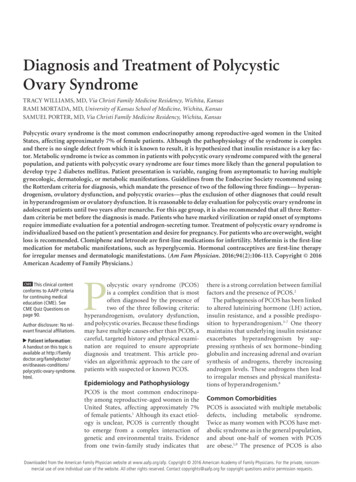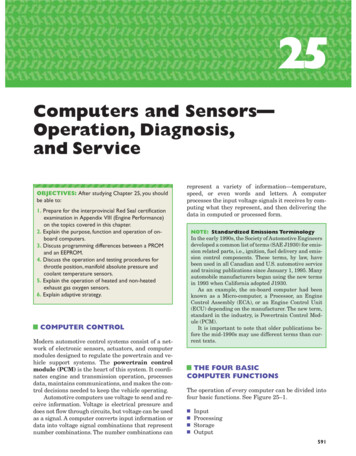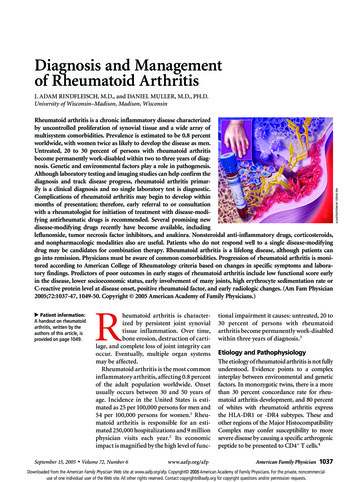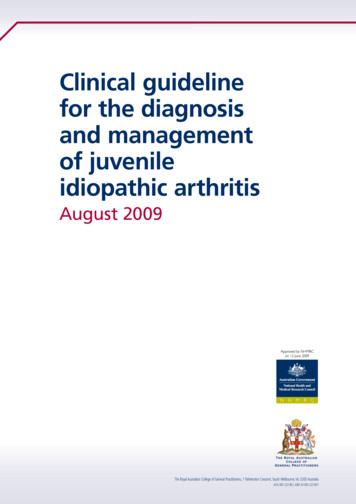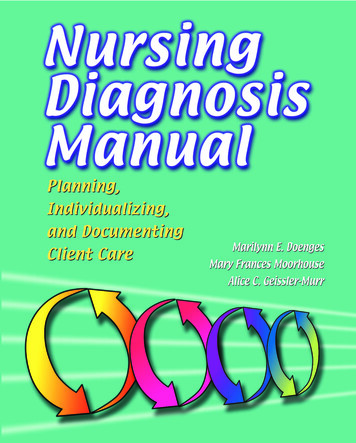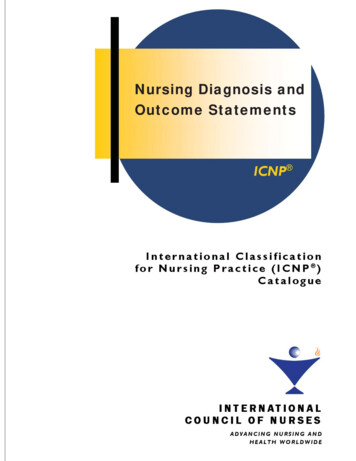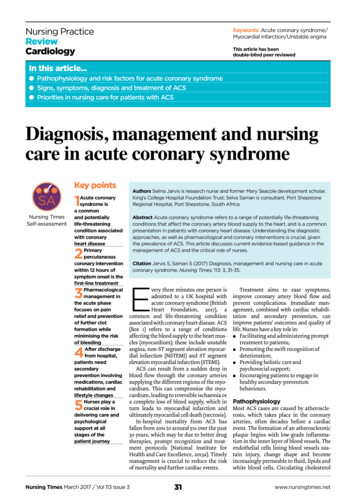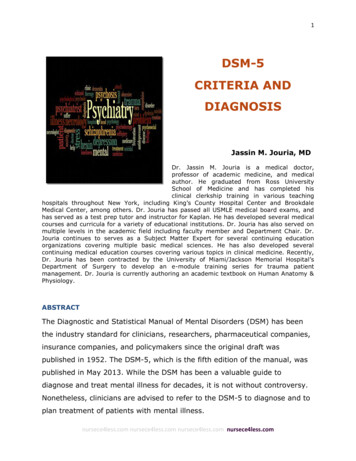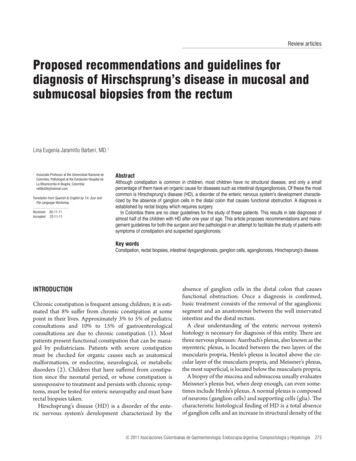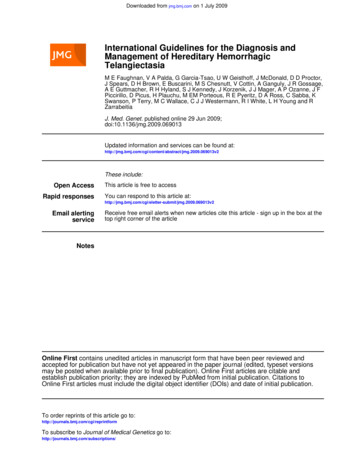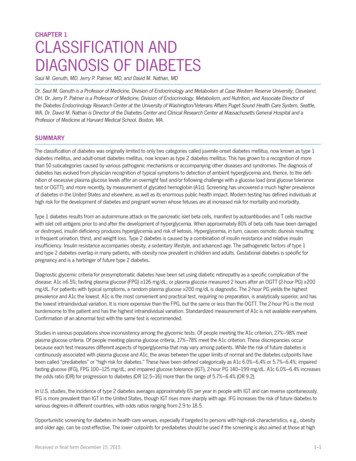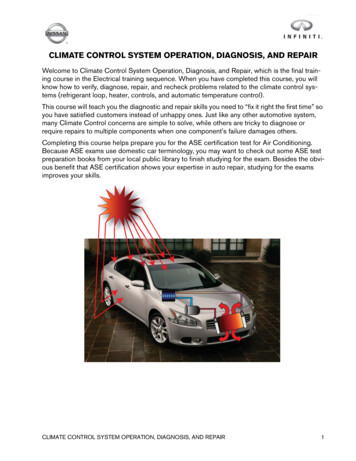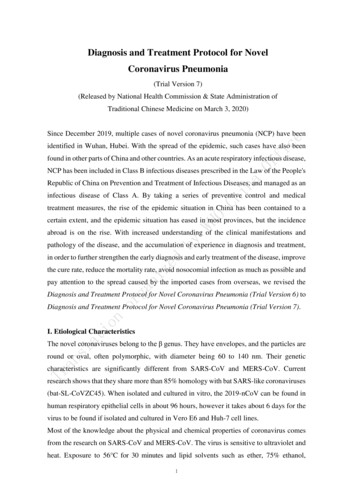
Transcription
Diagnosis and Treatment Protocol for NovelCoronavirus Pneumonia(Trial Version 7)(Released by National Health Commission & State Administration ofTraditional Chinese Medicine on March 3, 2020)Since December 2019, multiple cases of novel coronavirus pneumonia (NCP) have beenidentified in Wuhan, Hubei. With the spread of the epidemic, such cases have also beenfound in other parts of China and other countries. As an acute respiratory infectious disease,NCP has been included in Class B infectious diseases prescribed in the Law of the People'sRepublic of China on Prevention and Treatment of Infectious Diseases, and managed as aninfectious disease of Class A. By taking a series of preventive control and medicaltreatment measures, the rise of the epidemic situation in China has been contained to acertain extent, and the epidemic situation has eased in most provinces, but the incidenceabroad is on the rise. With increased understanding of the clinical manifestations andpathology of the disease, and the accumulation of experience in diagnosis and treatment,in order to further strengthen the early diagnosis and early treatment of the disease, improvethe cure rate, reduce the mortality rate, avoid nosocomial infection as much as possible andpay attention to the spread caused by the imported cases from overseas, we revised theDiagnosis and Treatment Protocol for Novel Coronavirus Pneumonia (Trial Version 6) toDiagnosis and Treatment Protocol for Novel Coronavirus Pneumonia (Trial Version 7).I. Etiological CharacteristicsThe novel coronaviruses belong to the β genus. They have envelopes, and the particles areround or oval, often polymorphic, with diameter being 60 to 140 nm. Their geneticcharacteristics are significantly different from SARS-CoV and MERS-CoV. Currentresearch shows that they share more than 85% homology with bat SARS-like coronaviruses(bat-SL-CoVZC45). When isolated and cultured in vitro, the 2019-nCoV can be found inhuman respiratory epithelial cells in about 96 hours, however it takes about 6 days for thevirus to be found if isolated and cultured in Vero E6 and Huh-7 cell lines.Most of the knowledge about the physical and chemical properties of coronavirus comesfrom the research on SARS-CoV and MERS-CoV. The virus is sensitive to ultraviolet andheat. Exposure to 56 C for 30 minutes and lipid solvents such as ether, 75% ethanol,1
chlorine-containing disinfectant, peracetic acid, and chloroform can effectively inactivatethe virus. Chlorhexidine has not been effective in inactivating the virus.II. Epidemiological Characteristics1. Source of infectionCurrently, the patients infected by the novel coronavirus are the main source of infection;asymptomatic infected people can also be an infectious source.2. Route of transmissionTransmission of the virus happens mainly through respiratory droplets and close contact.There is the possibility of aerosol transmission in a relatively closed environment for along-time exposure to high concentrations of aerosol. As the novel coronavirus can beisolated in feces and urine, attention should be paid to feces or urine contaminatedenvironment that may lead to aerosol or contact transmission.3. Susceptible groupsPeople are generally susceptible.III. Pathological changesPathological findings from limited autopsies and biopsy studies are summarized below:1.LungsVariable consolidation is present in the lungs.The alveoli are filled with fluid and fibrin with hyaline membrane formation.Macrophages and many multinucleated syncytial cells are identified within the alveolarexudates. Type II pneumocytes show marked hyperplasia and focal desquamation.Viralinclusions are observed in type II pneumocytes and macrophages. In addition, there isprominent edema and congestion in the alveolar septa which are infiltrated by monocytesand lymphocytes.Fibrin microthrombi are present.In more severely affected area,hemorrhage, necrosis, and overt hemorrhagic infarction are seen. Organization of alveolarexudates and interstitial fibrosis are also present.Detached epithelial cell and mucus are present in the bronchi, sometimes mucus plugs areseen.Hyperventilated alveoli, interrupted alveolar interstitium and cystic formation areoccasionally seen.By electronic microscopy, cytoplasmic 2019-nCoV virions are observed in the bronchialepithelium and type II pneumocytes. Immunostain reveals 2019-nCoV viral2
immunoreactivity in some alveolar epithelial cells and macrophages and RT-PCR confirmsthe presence of 2019-nCoV nucleic acid.2.Spleen, hilar lymph nodes and bone marrowThe spleen is markedly atrophic with a decreased number of lymphocytes.Focalhemorrhage and necrosis are present. Macrophages proliferation and phagocytosis arepresent in the spleen. Sparsity of lymphocytes and focal necrosis are noted in lymph nodes.CD4 and CD8 immunohistochemistry highlights a decreased number of T cells in thespleen and lymph nodes. Myelopoiesis is decreased in bone marrow.3.Heart and blood vesselsDegenerated or necrosed myocardial cells are present, along with mild infiltration ofmonocytes, lymphocytes and/or neutrophils in the cardiac interstitium. Shedding ofendothelial cells, endovasculitis and thrombi are seen in some blood vessels.4.Liver and gall bladderThe liver is dark-red and enlarged. Degeneration and focal necrosis of hepatocytes arefound, accompanied by infiltration of neutrophils. The sinusoids are congested. The portalareas are infiltrated by lymphocytes and histiocytes. Microthrombi are seen. Thegallbladder is prominently distended.5.KidneysThe kidneys are remarkable for proteinaceous exudates in the Bowman’s capsule aroundglomeruli, degeneration and shedding of renal tubules epithelial cells, and hyaline casts.Microthrombi and fibrotic foci are found in the kidney interstitium.6.Other organsCerebral hyperemia and edema are present, with degeneration of some neurons. Necroticfoci are noted in the adrenal glands. Degeneration, necrosis and desquamation ofepithelium mucosae of variable degree are present in the esophageal, stomach and bowel.IV. Clinical Characteristics1. Clinical manifestationsBased on the current epidemiological investigation, the incubation period is one to 14 days,mostly three to seven days.The main manifestations include fever, fatigue and dry cough. Nasal congestion, runnynose, sore throat, myalgia and diarrhea are found in a few cases. Severe patients developdyspnea and/or hypoxemia after one week and may progress rapidly to acute respiratorydistress syndrome, septic shock, refractory metabolic acidosis, coagulopathy, multiple3
organ failure etc. It is noteworthy that for severe and critically ill patients may only presentwith moderate to low fever, or even no fever at all.Some children and neonatal patients may have atypical symptoms, presented withgastrointestinal symptoms such as vomiting and diarrhea, or only manifested as lethargyand shortness of breath.The patients with mild symptoms usually do not develop pneumonia but have low feverand mild fatigue.Based on our experience, most patients have good prognosis and a small percentage ofpatients are critically ill. The prognosis for the elderly and patients with chronic underlyingdiseases is poorer. The clinical course of pregnant women with NCP is similar to that ofnon-pregnant patients of the same age. Symptoms in children are relatively mild.2. Laboratory testsGeneral findingsIn the early stages of the disease, peripheral WBC count is normal or decreased and thelymphocyte count is decreased. Some patients have elevated liver enzymes, lactatedehydrogenase (LDH), muscle enzymes and myoglobin. Elevated troponin is seen in somecritically ill patients. Most patients have elevated C-reactive protein and erythrocytesedimentation rate and normal procalcitonin. In severe cases, D-dimer increases andperipheral blood lymphocytes progressively decrease. Severe and critically ill patientsoften have elevated inflammatory factors.Pathogenic and serological findings(1) Pathogenic findings: Novel coronavirus nucleic acid can be detected in nasopharyngealswabs, sputum, lower respiratory tract secretions, blood, feces and other specimens usingRT-PCR and/or NGS methods. It is more accurate if specimens are obtained from lowerrespiratory tract (sputum or air tract extraction). The specimens should be submitted fortesting as soon as possible after collection.(2) Serological findings: NCP virus specific IgM becomes detectable around 3-5 days afteronset; IgG reaches a titration of at least 4-fold increase during convalescence comparedwith the acute phase.3. Chest imagingIn the early stage, imaging shows multiple small patchy shadows and interstitial changes,more apparent in the peripheral zone of lungs. As the disease progresses, imaging shows4
multiple ground glass opacities and infiltration in both lungs. In severe cases, pulmonaryconsolidation may occur. However, pleural effusion is rare.V. Case Definitions1. Suspect casesConsidering both the following epidemiological history and clinical manifestations:1.1 Epidemiological history1.1.1 History of travel to or residence in Wuhan and its surrounding areas, or in othercommunities where cases have been reported within 14 days prior to the onset of thedisease;1.1.2 In contact with novel coronavirus infected people (with positive results for the nucleicacid test) within 14 days prior to the onset of the disease;1.1.3 In contact with patients who have fever or respiratory symptoms from Wuhan and itssurrounding area, or from communities where confirmed cases have been reported within14 days before the onset of the disease; or1.1.4 Clustered cases (2 or more cases with fever and/or respiratory symptoms in a smallarea such families, offices, schools etc within 2 weeks).1.2 Clinical manifestations1.2.1 Fever and/or respiratory symptoms;1.2.2 The aforementioned imaging characteristics of NCP;1.2.3 Normal or decreased WBC count, normal or decreased lymphocyte count in the earlystage of onset.A suspect case has any of the epidemiological history plus any two clinical manifestationsor all three clinical manifestations if there is no clear epidemiological history.2. Confirmed casesSuspect cases with one of the following etiological or serological evidences:2.1 Real-time fluorescent RT-PCR indicates positive for new coronavirus nucleic acid;2.2 Viral gene sequence is highly homologous to known new coronaviruses.2.3 NCP virus specific Ig M and IgG are detectable in serum; NCP virus specific IgG isdetectable or reaches a titration of at least 4-fold increase during convalescence comparedwith the acute phase.5
VI. Clinical Classification1.Mild casesThe clinical symptoms were mild, and there was no sign of pneumonia on imaging.2.Moderate casesShowing fever and respiratory symptoms with radiological findings of pneumonia.3.Severe casesAdult cases meeting any of the following criteria:(1) Respiratory distress ( 30 breaths/ min);(2) Oxygen saturation 93% at rest;(3) Arterial partial pressure of oxygen (PaO2)/ fraction of inspired oxygen (FiO2) 300mmHg (l mmHg 0.133kPa).In high-altitude areas (at an altitude of over 1,000 meters above the sea level), PaO2/ FiO2shall be corrected by the following formula:PaO2/ FiO2 x[Atmospheric pressure (mmHg)/760]Cases with chest imaging that shows obvious lesion progression within 24-48 hours 50%shall be managed as severe cases.Child cases meeting any of the following criteria:(1) Tachypnea (RR 60 breaths/min for infants aged below 2 months; RR 50 BPM forinfants aged 2-12 months; RR 40 BPM for children aged 1-5 years, and RR 30 BPMfor children above 5 years old) independent of fever and crying;(2) Oxygen saturation 92% on finger pulse oximeter taken at rest;(3) Labored breathing (moaning, nasal fluttering, and infrasternal, supraclavicular andintercostal retraction), cyanosis, and intermittent apnea;(4) Lethargy and convulsion;(5) Difficulty feeding and signs of dehydration.4.Critical casesCases meeting any of the following criteria:4.1 Respiratory failure and requiring mechanical ventilation;4.2 Shock;4.3 With other organ failure that requires ICU care.VII. Clinical early warning indicators of severe and critical cases6
1. Adults.1.1 The peripheral blood lymphocytes decrease progressively;1.2 Peripheral blood inflammatory factors, such as IL-6 and C-reactive proteins, increaseprogressively;1.3 Lactate increases progressively;1.4 Lung lesions develop rapidly in a short period of time.2. Children.2.1 Respiratory rate increased;2.2 Poor mental reaction and drowsiness;2.3 Lactate increases progressively;2.4 Imaging shows infiltration on both sides or multiple lobes, pleural effusion or rapidprogress of lesions in a short period of time;2.5 Infants under the age of 3 months who have either underlying diseases (congenital heartdisease, bronchopulmonary dysplasia, respiratory tract deformity, abnormal hemoglobin,and severe malnutrition, etc.) or immune deficiency or hypofunction (long-term use ofimmunosuppressants).VIII. Differential Diagnosis1. The mild manifestations of NCP need to be distinguished from those of upper respiratorytract infections caused by other viruses.2. NCP is mainly distinguished from other known viral pneumonia and mycoplasmapneumoniae infections such as influenza virus, adenovirus and respiratory syncytial virus.For suspect cases, efforts should be made to use methods such as rapid antigen detectionand multiplex PCR nucleic acid testing for detection of common respiratory pathogens.3. NCP should also be distinguished from non-infectious diseases such as vasculitis,dermatomyositis and organizing pneumonia.IX. Case Finding and ReportingHealth professionals in medical institutions of all types and at all levels, upon discoveringsuspect cases that meet the definition, should immediately keep them in single room forisolation and treatment. If the cases are still considered as suspected after consultationmade by hospital experts or attending physicians, it sho
diseases is poorer. The clinical course of pregnant women with is similar to that of NCP non-pregnant patients of the same age. Symptoms in children are relatively mild. 2. Laboratory tests . General findings In the early stages of the disease, peripheral WBC countis normal or decreased and the lymphocyte count is decreased. Some patients have elevated liver enzymes, lactate
